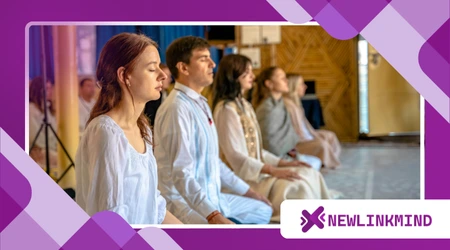Managing Burnout Through Workplace Meditation

Managing burnout through workplace meditationIn our fast-paced world, the constant pressure to be productive and always-on has led to a silent epidemic in the professional sphere.
Anúncios
The relentless pursuit of success often comes at a steep price: burnout.
While this state of emotional, physical, and mental exhaustion is widespread, the good news is that we’re seeing an evolution in how workplaces and individuals are addressing it.
Among the most promising and accessible strategies is managing burnout through workplace meditation.
The Looming Shadow of Burnout
Burnout isn’t just about feeling tired; it’s a profound state of chronic stress that has gone unchecked.
Anúncios
The World Health Organization officially recognized it as an occupational phenomenon in its 11th Revision of the International Classification of Diseases (ICD-11).
It’s characterized by three key dimensions: feelings of energy depletion or exhaustion, increased mental distance from one’s job, and reduced professional efficacy.
For too long, the solution has been to simply “push through,” but this approach is proving to be both unsustainable and damaging to our well-being and long-term career growth.
Anúncios
The cost of inaction is too high, impacting not just individual lives but also organizational performance.
A Mindful Anchor in a Chaotic Sea
When we think about our minds at work, they often resemble a browser with too many tabs open at once.
Each tab represents a task, a deadline, an email, or a meeting, all competing for our attention.
This constant switching drains cognitive resources and makes it difficult to focus on what truly matters. Meditation acts as a way to close some of those unnecessary tabs, freeing up mental bandwidth and reducing the friction that leads to emotional overload.
Read more: How to Create a Quiet Meditation Space at Work
It’s not about emptying the mind but about learning to observe the thoughts and feelings that arise without being swept away by them.
In doing so, we can create a necessary pause between stimulus and response, a space where we can choose to react with intention rather than on autopilot.

The Science Behind the Calm
The effectiveness of meditation in combating stress is well-documented.
A 2018 study published in the journal Health Psychology found that mindfulness-based stress reduction (MBSR) programs led to significant reductions in perceived stress and an improvement in mood among participants.
When we engage in mindful practices, we activate the parasympathetic nervous system, our body’s “rest and digest” mode.
This counters the sympathetic nervous system’s “fight or flight” response, which is constantly on high alert during periods of prolonged stress.
This neurological reset helps lower heart rate, reduce blood pressure, and calm the physiological symptoms of anxiety.
Incorporating these moments of quiet can fundamentally change our physical and mental state, making us more resilient to the daily stressors that contribute to burnout.
Workplace Meditation Is Not a Luxury, But a Necessity
Once considered an esoteric practice, meditation is now embraced by leading organizations as a vital tool for employee well-being.
This shift reflects a growing understanding that a healthy workforce is a productive workforce. Organizations are no longer simply paying lip service to well-being; they’re investing in tangible solutions.
Imagine a company where a quick five-minute guided meditation is offered before a high-stakes meeting, or where a quiet room is designated for employees to take a mindful break.
++ The Science Behind Meditation and Workplace Performance
These small changes can have a profound ripple effect, creating a culture that values mental health and recognizes the importance of intentional rest.
It’s a proactive strategy, far more effective than trying to manage the fallout of an overwhelmed workforce.
Practical Approaches for Managing Burnout Through Workplace Meditation
Adopting a meditation practice at work doesn’t require a significant time commitment or a special setup. It’s about finding small pockets of time to recenter yourself.
Example 1: The Commuter’s Pause
Maria, a project manager, used to spend her 45-minute bus commute mentally rehearsing her day’s conflicts. She’d arrive at the office already feeling defeated.
After learning about mindfulness, she started using her commute as a transition. She would close her eyes, breathe deeply for five minutes, and simply observe the sounds of the city and the feeling of her feet on the floor.
She wasn’t trying to solve problems; she was just being present. By the time she reached her desk, she felt grounded and ready to face her day with a clear head, having left the mental clutter of her commute behind.
Read here: How Meditation Can Support a Healthy Retirement Lifestyle
Example 2: The Lunchtime Reset
A software engineer named Leo found himself eating lunch at his desk while scrolling through his phone, a pattern that left him feeling heavy and unfocused in the afternoon.
Instead, he decided to dedicate the first ten minutes of his lunch break to a simple practice.
He’d find a quiet spot, put his phone away, and perform a body scan meditation, bringing his awareness to each part of his body from his toes to his head.
This practice wasn’t about escaping the office; it was about truly stepping away and giving his mind a chance to rest and recharge.
He found that the simple act of focusing on his body made him feel more energized and prepared for the second half of his day.

A Simple Table for a Quick Start
| Technique | Time Commitment | When to Use | Benefits |
| Mindful Breathing | 2-5 minutes | Before a meeting, after receiving a stressful email | Reduces heart rate, calms the nervous system, improves focus |
| Body Scan | 5-10 minutes | During a lunch break or a brief solo walk | Releases physical tension, fosters present-moment awareness |
| Walking Meditation | 10-15 minutes | A short walk around the office or outside | Integrates mindfulness with movement, clears the mind |
| Loving-Kindness Meditation | 5 minutes | When feeling frustrated with a colleague | Promotes empathy, reduces irritability, fosters positive emotions |
The Domino Effect of Mindfulness
A single act of mindfulness can create a powerful domino effect.
By taking a moment to breathe, you can diffuse a tense conversation, prevent a rushed decision, and improve the quality of your work. The cumulative effect of these small, mindful moments over time is a significant reduction in the overall mental load we carry.
This isn’t just about managing stress; it’s about building an inner resilience that allows us to thrive even under pressure.
Isn’t a calmer, more focused and energized workforce a far better investment than endless hours of uninspired and exhausted work?
This is why managing burnout through workplace meditation is becoming a core part of modern corporate wellness.
Embracing the Human Side of Productivity
According to a 2024 study by the American Psychological Association, 79% of employees reported experiencing work-related stress, with burnout being a top concern.
This sobering statistic underscores the urgency of proactive solutions. By investing in meditation programs, companies are sending a clear message:
that employees are not just cogs in a machine, but human beings with mental and emotional needs.
This approach builds trust and loyalty, fostering a work environment where people feel valued and supported.
It’s a shift from a purely transactional relationship to one that acknowledges and supports holistic well-being.
The journey toward managing burnout through workplace meditation is a collective one.
It involves individuals taking personal responsibility for their well-being and organizations creating the space and support for it to flourish.
When we allow ourselves to be fully present, we not only perform better but also experience a greater sense of fulfillment and purpose.
This is the future of work: one where productivity and humanity are not at odds but are instead mutually reinforcing.
Frequently Asked Questions
Q: Do I have to sit in a specific position or chant to meditate?
A: Not at all. Meditation can be as simple as focusing on your breath while sitting at your desk.
You don’t need any special equipment or poses. The goal is simply to bring your attention to the present moment, no matter where you are or what you’re doing.
Q: How can I convince my company to offer meditation resources?
A: Focus on the tangible benefits. Present a case to HR or management that highlights the proven link between mindfulness and reduced stress, improved focus, and increased productivity.
You can also point to data on the high costs of burnout-related turnover and absenteeism.
Q: Can meditation really make a difference if my job is inherently stressful?
A: Yes. Meditation doesn’t eliminate stress, but it changes your relationship with it.
It builds your capacity to handle pressure more effectively, allowing you to respond to challenges with clarity and calm rather than being overwhelmed by them.
Q: What if I have trouble quieting my mind during meditation?
A: That’s a common experience. The goal of meditation isn’t to have a quiet mind, but to notice when your mind wanders and gently bring it back to your anchor, like your breath.
Every time you do this, you are strengthening your “mindfulness muscle.” It’s a practice, not a performance.
